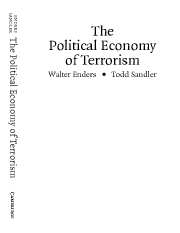Book contents
- Frontmatter
- Contents
- List of Tables and Figures
- Preface
- 1 Terrorism : An Introduction
- 2 The Dilemma of Liberal Democracies
- 3 Statistical Studies and Terrorist Behavior
- 4 Counterterrorism
- 5 Transference
- 6 International Cooperation : Dilemma and Inhibitors
- 7 Hostage Taking
- 8 After 9/11
- 9 The Economic Impact of Transnational Terrorism
- 10 Homeland Security
- 11 The Future of Terrorism
- References
- Author Index
- Subject Index
Preface
Published online by Cambridge University Press: 06 July 2010
- Frontmatter
- Contents
- List of Tables and Figures
- Preface
- 1 Terrorism : An Introduction
- 2 The Dilemma of Liberal Democracies
- 3 Statistical Studies and Terrorist Behavior
- 4 Counterterrorism
- 5 Transference
- 6 International Cooperation : Dilemma and Inhibitors
- 7 Hostage Taking
- 8 After 9/11
- 9 The Economic Impact of Transnational Terrorism
- 10 Homeland Security
- 11 The Future of Terrorism
- References
- Author Index
- Subject Index
Summary
Prior to the four hijackings of 11 September 2001 (hereafter 9/11), the study of terrorism was an active field of research, with many new books appearing each year. Since 9/11, the study of terrorism is an even more active field of research, with even more books appearing each year. Hence, one must wonder why another book merits one's attention.
This book presents a widely accessible political economy approach that combines economic methods with political analysis and realities. In so doing, the book provides both a qualitative and a quantitative investigation of terrorism in a balanced, up-to-date presentation that informs students, practitioners, policymakers, researchers, and the general reader of the current state of knowledge. Most books on terrorism focus on historical, cultural, factual, and conceptual details and shy away from rational-choice-based analyses backed by statistical inference. Our book presents not only the historical and conceptual issues, but also the scientific-based analyses of the behavior of terrorists and government policymakers. Moreover, we are concerned with knowing how these adversaries make rational decisions in a strategic interactive framework. That is, how do the choices of the terrorists influence governments' counterterrorism policies, and how do these policies affect the choices of the terrorists? The strategic interactions among targeted governments are also investigated. To establish the relevancy of the theories presented, we display data and review statistical findings from a variety of studies.
- Type
- Chapter
- Information
- The Political Economy of Terrorism , pp. xi - xivPublisher: Cambridge University PressPrint publication year: 2005

